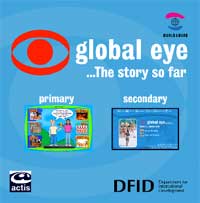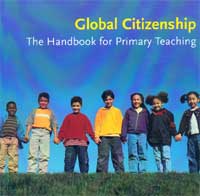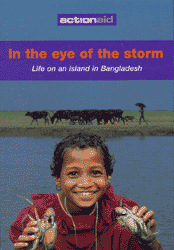| Global Eye Primary:
Teachers' Notes Summer 2002
Introduction/Eye
on South Pacific /Focus on Climate change/Competitions/Credits
Welcome
to the sixth edition of the Global Eye Primary website. Global
Eye Primary was launched in September 2000 to complement the
Global Eye magazine and website for secondary schools. The
five previous editions of Global Eye Primary are still on-line
in the 'Back Issue Archive'
section of the website.
 Global
Eye CD-ROM - the story so far Global
Eye CD-ROM - the story so far
Save on internet access and download time with the
CD-ROM of www.globaleye.org.uk !
The CD-ROM allows you to access every edition of
Global Eye Primary up to and including Spring 2002
on a stand-alone computer or school intranet system.
In addition, the CD-ROM contains every edition of
Global Eye Secondary, providing a wealth of images
and information for you to download for teaching
purposes. Like the website version, the CD-ROM's
'back issue archive'
section contains an index that allows users to search
for Global Eye coverage of a developing country
or development theme.
Order
from www.worldaware.org.uk
(Code PA-171) £15.00 (including site licence) |
|
The aim of Global Eye
Primary is to provide interesting, well-illustrated and interactive
material about developing countries and global issues to tie
in with UK primary curriculum requirements.
Three characters, Harry,
Cecile and Jack (a parrot) guide pupils around the website,
answering their questions and challenging them to think about
a variety of development issues.
Each section of the website
uses interactive features, key questions and photos to break
down the issues covered into manageable chunks. The sections
of Global Eye Primary are:
The sections of Global
Eye Primary are:
Eye
on a specific case study of a developing country including
maps, diagrams, tables, a variety of photographs and a data
file.
Focus
on looks at a development issue and uses case studies
to show how it affects people in developing countries.
On
Camera images from locations in the developing world with
accompanying questions and activities for pupils.
Competitions
prize-winning competitions for individual pupils and group
projects.
top
Click
here to see details of how the
skills and content of the Global Eye Primary Summer 2002 web
pages can be applied to different subject criteria in the
primary curriculum. There are also references to the National
Curriculum targets in England & Wales.
| Please let
us know what you think of Global Eye Primary including
ways in which your pupils have used the website,
what you would like to see featured in future editions,
and any other ideas and comments. We need your input
to help the site develop and grow. Contact the editor,[email protected] |
|
NEW RESOURCES
Global Citizenship:
The Handbook for Primary Teaching by Mary Young with Ellish
Commins (Oxfam Education & Chris Kington Publishing 2002)
 This
excellent 188 page handbook develops the principles of global
citizenship into clear, practical pointers for use in schools.
Includes over thirty photocopiable texts and worksheets, curriculum
relevance and guidance for teachers, and a wealth of other
useful information. Highly recommended. Available from www.worldaware.org.uk
(code B-385) £29.00 (including P+P). This
excellent 188 page handbook develops the principles of global
citizenship into clear, practical pointers for use in schools.
Includes over thirty photocopiable texts and worksheets, curriculum
relevance and guidance for teachers, and a wealth of other
useful information. Highly recommended. Available from www.worldaware.org.uk
(code B-385) £29.00 (including P+P).
Resources on Chembakolli
The Chembakolli:
Life and Change in an Indian Village photopack (Action
Aid 2002) has been updated.
This is a comprehensive locality study as well as an inspiring
global context for PSHE and Citizenship. Through colour photographs,
comic strips and activity sheets, pupils explore life and
change in an Adivasi village, the landscape of the area, and
links with the wider world. The updated photopack is available
from www.worldaware.org.uk
(code PA-167) £19.00 including P+P.

Become a
registered user of www.chembakolli.com
and you can download resources for the price of a photopack
as much and as often as you like. For £17.25, you have
unlimited access to the photos, songs, panoramas, lesson plans,
profiles and information sheets (for 12 months). The resources
are worth over £200 - an offer not to be missed. See
the flyer below for details:
RESOURCES SUGGESTIONS
TO SUPPLEMENT PRIMARY GLOBAL EYE SUMMER 2002
|
Climate
Change exhibition at the Science Museum, London
 Tapping
into the most recent research and scientific opinion,
the Science Museum's new Antenna exhibition about
climate change explores the major climate change
issues: causes, impacts and solutions. Pupils
are able to find out how much of a role they have
to play, and consider comments and opinions from
people all around the world. Tapping
into the most recent research and scientific opinion,
the Science Museum's new Antenna exhibition about
climate change explores the major climate change
issues: causes, impacts and solutions. Pupils
are able to find out how much of a role they have
to play, and consider comments and opinions from
people all around the world.
Topics
covered in the exhibition include:
- What is
climate change?
- How do
we know that our climate is changing?
- What's
going to happen and how will this affect people?
- What can
we do?
To complement
the exhibition pupils can enjoy watching The Blue
Planet large format film in the Museum's IMAX®
cinema. They could also visit the Weather gallery.
This exhibition
on climate change is jointly sponsored by the
Engineering and Physical Sciences Research Council
and the Natural Environment Research Council.
Additional support was provided by the Department
for International Development (DFID).
IMAX®
is the registered trademark of the Imax Corporation
Educational visits to the Science Museum
Admission
to the Science Museum is free although educational
groups are asked to pre-book. Admission charge
applies for IMAX cinema.
Contact the
Education Booking Office, Tel: 020 7942 4777,
e-mail: [email protected],
web: www.sciencemuseum.org.uk/learning
Other websites
on climate change that are suitable for primary
school pupils include:
http://www.epa.gov/globalwarming/kids/index.html
http://globalwarming.enviroweb.org/games/index.html
http://www.defra.gov.uk/environment/climatechange/schools/7-11/index.htm
http://www.oneworld.net/penguin/global_warming/climate_home.html
|
|
 In
the Eye of the Storm: Bangladesh by Lucy Marcovitch (Action
Aid 2001) is a non-fiction book for 7-11 year olds investigating
family life on the cyclone-prone island of Kukri Mukri, Bangladesh.
The book contains photographs with a variety of text styles,
teachers' information and activities. The book also comes
in two sizes; the 'big book' is available from www.worldaware.org.uk
(code B-121) £17.25 and the A5 size of the book is available
from www.worldaware.org.uk
(code B-578) £6.25, or in a pack of six books (code
B-379) £32.00. In
the Eye of the Storm: Bangladesh by Lucy Marcovitch (Action
Aid 2001) is a non-fiction book for 7-11 year olds investigating
family life on the cyclone-prone island of Kukri Mukri, Bangladesh.
The book contains photographs with a variety of text styles,
teachers' information and activities. The book also comes
in two sizes; the 'big book' is available from www.worldaware.org.uk
(code B-121) £17.25 and the A5 size of the book is available
from www.worldaware.org.uk
(code B-578) £6.25, or in a pack of six books (code
B-379) £32.00.
In the Eye of the
Storm: Cyclones in the Bay of Bengal (Action Aid 1999)
is an audio disk for CD players and computers and a CD-ROM
of digital images, video, text and diagrams, providing a study
of the effects of cyclones on a disaster-prone island off
the coast of Bangladesh. CD-ROM (Windows and Mac OS). Available
from http://www.worldaware.org.uk/
(code PA-136) £17.25.
CREDITS
The Global
Eye Primary website, Summer 2002 was written by Simon Scoones.
Contributions and assistance
from:
Nadine Park, Worldaware
Julia Pickles, St. Olaves School, York
Kate Russell, Advisor for Geography, QLS, Staffordshire LEA
www.sln.org.uk
Pat Trussell
Worldaware
Echo House
Ullswater Crescent
Coulsdon
Surrey CR5 2HR
Tel: 020 8763 2555
Fax: 020 8763 2888
www.worldaware.org.uk
E Mail (General Enquiry): [email protected]
E Mail (Global Eye): [email protected]
top
|